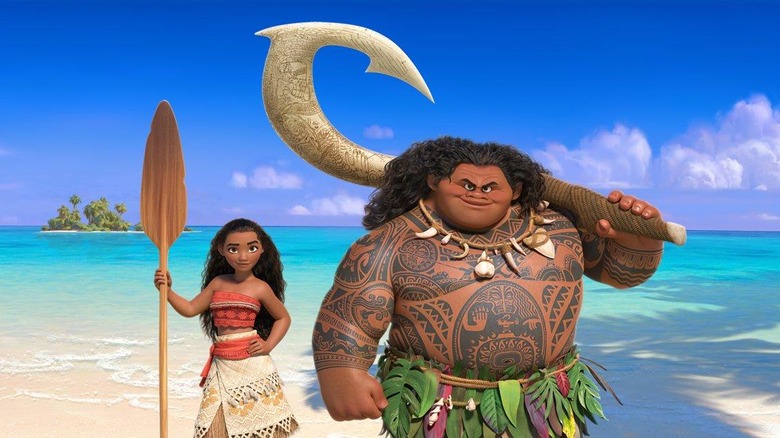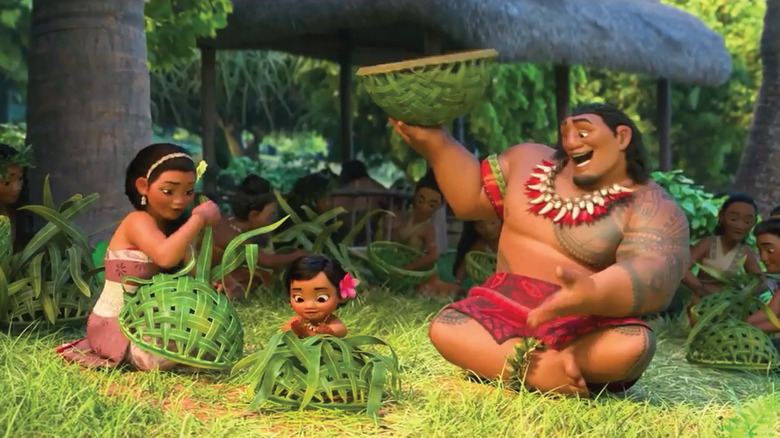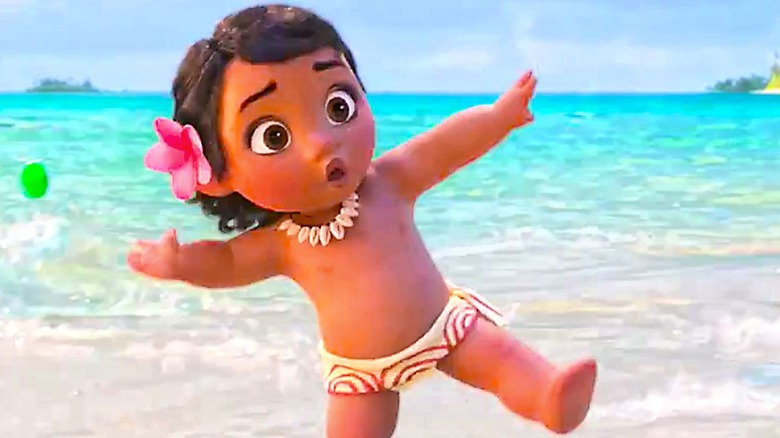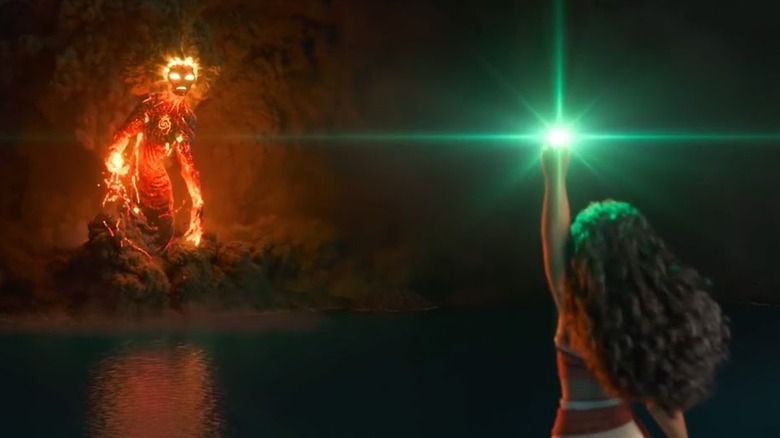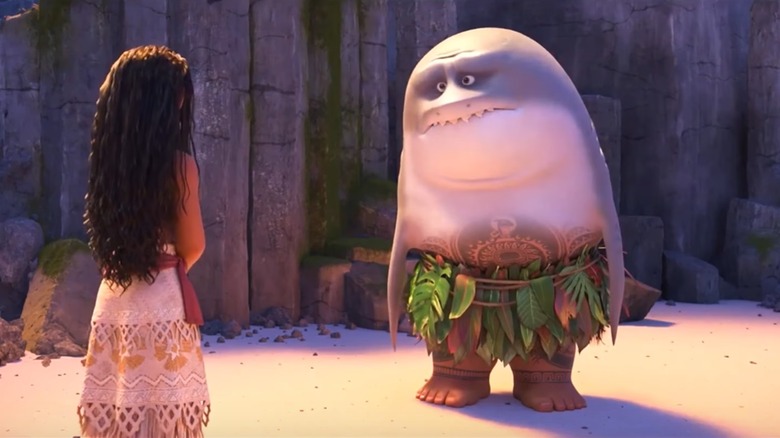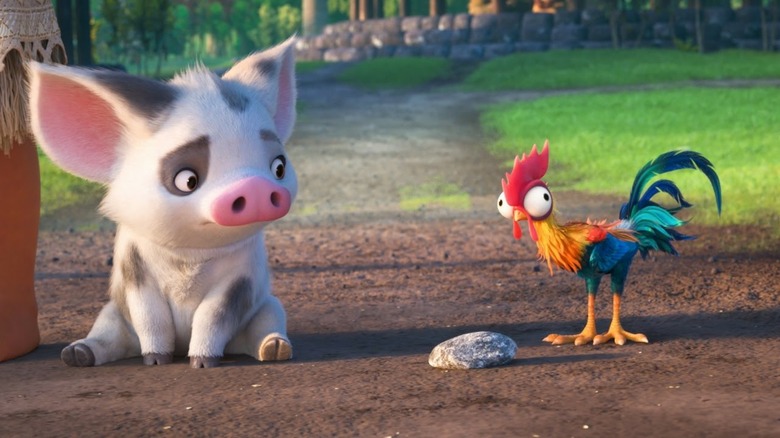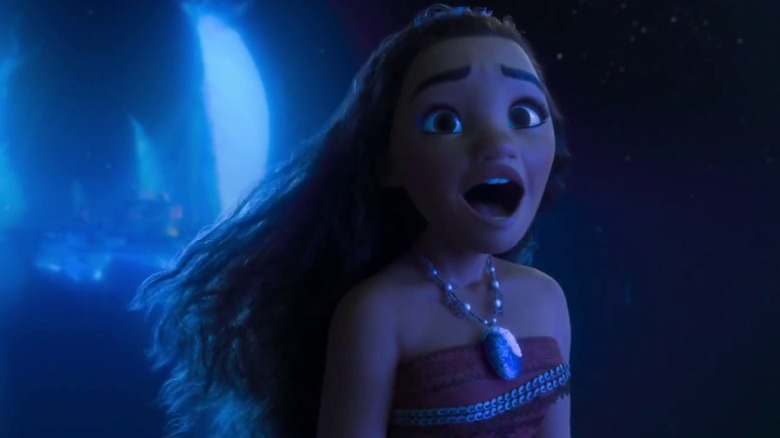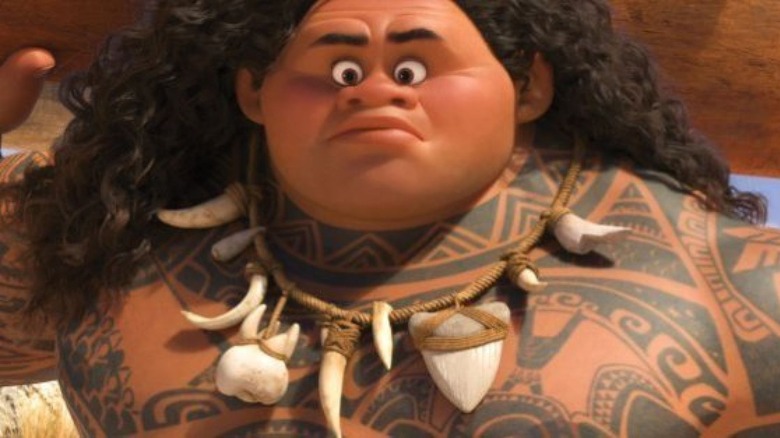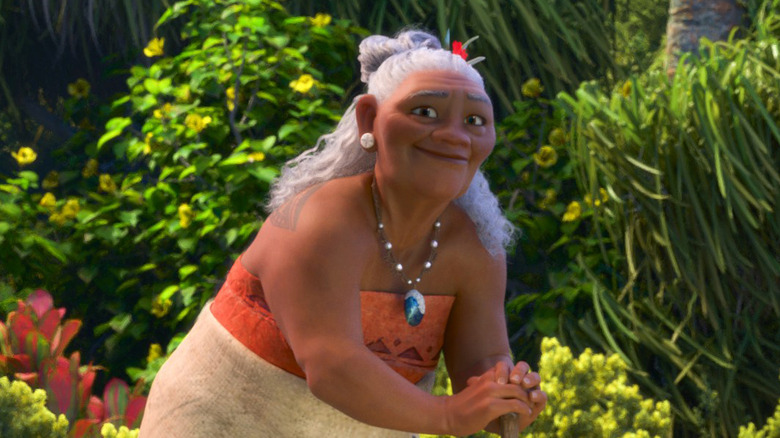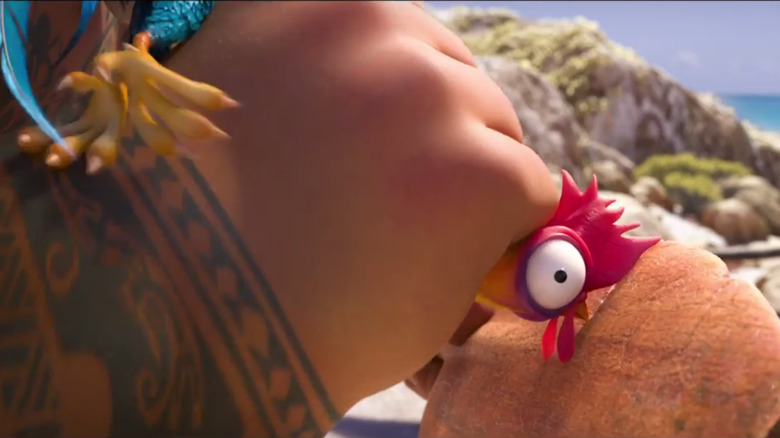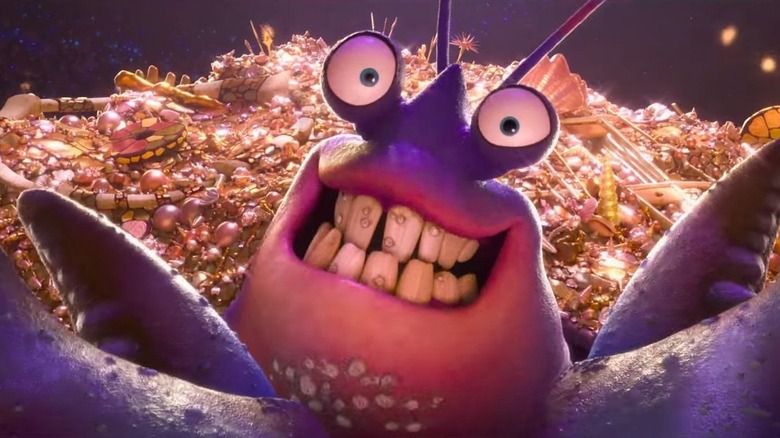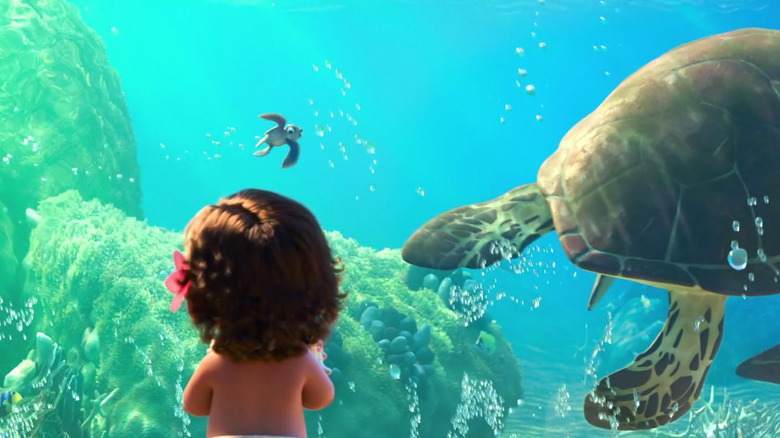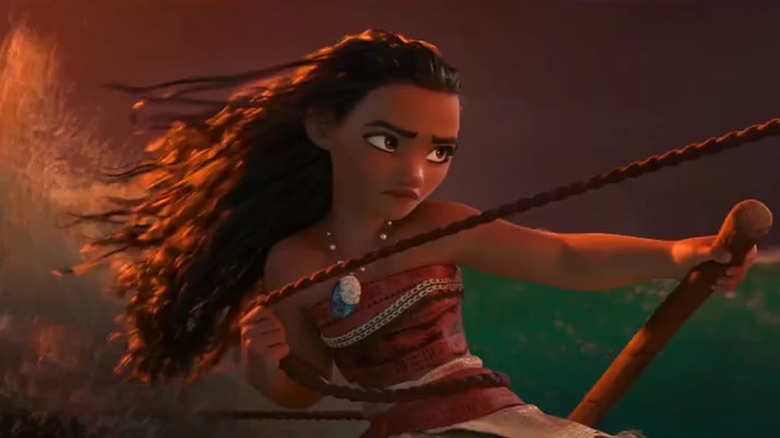Things About Moana You Only Notice As An Adult
As a parent of two young children, and a fully committed Disney-phile, I try to stay abreast on the latest Disney movies. And by stay abreast, I mean I will sit and watch them 300 times with my kids until I can not only memorize lines, but find plot holes, create conspiracy theories, and dream in full-color animation.
I'll admit that when I saw the previews for Moana, I thought it was just a way for Disney to capitalize on their newest hibiscus-themed timeshare resort in Hawaii. I naively expected a watered-down remake of Lilo and Stitch, but what I got was a surprisingly heartwarming tale rooted in Polynesian culture. But while my kids giggled at the silly antics of a mentally unstable chicken, I noticed a few things that might only be caught through the jaded eyes of adulthood.
Be warned: spoilers abound.
Moana's parents are total Millennials
Moana's village might have been located on the deserted Polynesian island of Motunui without smartphones and hybrid cars, but her parents, Chief Tui and his wife Sina, were classic Millennial helicopter parents.
While Moana's grandmother Tala regaled the children with stories of the island, Sina and Chief Tui weren't interested in the old fashioned notions of "the village crazy lady." And while it sounds like in Moana's parents' generation (back in the day), kids were allowed to roam free beyond the reef, Moana wasn't allowed to venture very far. This is characteristic of helicopter parenting in which the parents' own experiences and subsequent anxieties and fears of bad outcomes lead to being overprotective of their children.
If being helicopter parents who shun the old ways doesn't convince you that Moana's parents are Millennials, consider that they also probably have a pretty healthy obsession with coconut oil. I mean, they have dedicated their entire agricultural system to coconuts and using every part of the crop.
There is zero water safety going on
Moana's dad sings an entire song about not going out past the reef, but early in the movie we see that there really is zero water safety going on when she is in diapers. I know it's hard to watch kids at all times, but while Moana's father is chastising his own mother for scaring the toddlers with legends about "inescapable death," Moana toddles out to sea.
If that were real life, the story would be splashed on social media, Moana's dad would be in jail, and the mommy shamers would be out in full force. Luckily the ocean has human characteristics and good intentions when it tempts the toddler out to sea with conch shells. But while Moana seems annoyed throughout the movie because her father is adamant that she stay away from the water, as a parent I wonder if she brought that on herself by constantly running out to sea without a life saving device or even a pair of floaties.
Moana could have returned the heart of Te Fiti herself
The beginning of the movie shows that the demigod Maui has stolen the heart of Te Fiti, dooming all of mankind. Legend says "the chosen one" must find the heart and force Maui to return it, but in the end Moana is the one who returns the heart and saves the planet.
I was only about ten minutes into the movie before I'm questioning Maui's part in this. It seems like the ocean keeps giving Moana the green rock, and even Maui calls out the plot line saying if the ocean is so smart it should return the heart itself. I thought maybe Te Fiti would only forgive humankind if Maui admitted his mistake. But Te Fiti calms down as soon as Moana gives her back the heart. Mo could have saved herself a lot of grief if she'd just gone on her own. But I suppose then Maui wouldn't have gotten his hook back, and Te Fiti wouldn't have gotten her apology.
Sharks must have pockets
Maui's shapeshifting is no doubt impressive, but even more impressive is the fact that he shapeshifts into animals with pockets. Maui often transforms while holding the heart of Te Fiti or at the very least while holding his hook. But when he takes the form of a shark or a hawk, the objects are nowhere to be seen.
We looked closely to see if maybe the hawk was holding the heart in his talons, but didn't see it, and in his shark form there are no talons to hold anything. Either his animal bodies have teeny pockets, or he absorbs these items into his body, which leads me to question how they get out when he transforms back into a human. Seems painful, especially when he turns into a tiny beetle.
There's also a third option. There's a blink-and-miss-it hint of what happens to the hook when Maui transforms. If you look closely at Maui's wing when he becomes a hawk, you'll see the shape of the hook in his feathers. Seems as though the hook becomes a tattoo-like symbol while he's in shape-shift mode. Though, this doesn't answer what happens to the heart of Te Fiti, and we really like the visual of a shark with little pockets, so we're going to have to stick with that.
Pigs are bad luck
Pua is a little dog-like sidekick who follows Moana around the island. This little piggy seems harmless, and we even feel sad for him when Moana scarfs down a huge bite of pork while he watches in horror. But I can't help but wonder if that sweet little swine has some bad mojo.
When Moana decides to voyage out on the boats for the first time, Pua jumps on board. Her boat makes it over the first wave, but Pua is tossed overboard. Then while Moana turns to save him a giant wave capsizes her boat and she's trapped under water. Every other ocean quest is met with help from the water, but during this swine-ful attempt the ocean almost kills her.
When Moana finally washes up on shore with the stunned piglet, her grandmother walks up and says "Whatever just happened, blame the pig." The next voyage, Moana leaves the little bacon bit on the island and sets sail with the ditzy chicken, and her mission is successful. It had me wondering if the ocean had some kind of pork aversion, or if Pua was just bad luck.
The music is legitimately amazing
I have probably seen Moana more than 30 times, and the music never gets old. Frozen may have busted out of the box office with Golden Globe nominations, and Academy Award and Grammy wins for its music, but Moana gave me songs that I'd put in my own personal playlist.
The song "How Far I'll Go" is so powerful, that it still gives me chills after the 50th time I hear it. And I'm not the only one who gets amped up when this jam comes on. One 4-year-old broke the internet when the spirit moved her through that song. Samoan singer and songwriter Opetaia Fao'i collaborated on the soundtrack — writing "We Know the Way" among other songs — which also pumps up the authenticity of the music. In a touchy time of cultural appropriation, I was glad to know they consulted and took direction from the people they wanted to represent.
You're Welcome is all of us
While songs like "How Far I'll Go" and "We Know the Way" are moving and heartfelt, the one I actually identify with as a parent is "You're Welcome" when Moana shows up on Maui's island demanding he take her to Te Fiti. Sure, Maui might be a little full of himself, but no one can deny that the demigod has definitely done a lot for Moana's people (if we just ignore the whole stealing the heart of Te Fiti thing).
As parents, how many times have our kids rolled up on us making demands for us to shuttle them somewhere without taking a moment to realize that we've already moved mountains for them without so much as a thank you? It's nice to have a melody to churn out the next time my child forgets that I'm the reason the sun even rises and sets on her world.
The grandma's plot line destroyed me
The crazy grandma actually has to be my favorite character in the movie, because she's a strong woman with a great sense of humor. When she comes across Moana after her failed attempt to get beyond the reef, Moana is worried her grandmother is going to tell her father about what she's done. Tala replies with a smile, "I'm his mom, I don't have to tell him anything."
After being solidly established as Moana's trusted confidant, Gramma Tala is seen swaying in the water and grazing the backs of the circling rays. In that moment she tells Moana, "When I die, I'm going to come back as one of these, or I chose the wrong tattoo."
The grandmother doesn't live much longer after that, and as Moana sets out on her greatest adventure, a great light explodes and a beautiful glowing ray glides swiftly under her boat and out to sea, jumping majestically into the air. If you can watch this movie in its entirety including the scene where Gramma Tala's spirit helps Moana find her inner strength and identity, and not cry — you are dead inside.
They threw in a few cheeky jokes
In true Disney fashion, there are a few corny jokes thrown in especially for the parents and babysitters in the crowd. My kids are still small enough that their knowledge of social media outlets is fairly limited, so when Maui says, "When you write with a bird, it's called tweeting," I think Disney was trying to make me feel hip for getting the reference. For all I know Twitter is so last year, and Disney's dorky dad jokes are only funny to people with fanny packs and mini vans. But I'm not too proud to admit I actually chuckled out loud.
They also threw in a little toilet humor when an outstretched Maui tells Moana that warmer water means she's going the right way. Technically pee humor is on level for my 8-year-old, but let's face it, potty jokes will always be funny at any age.
Tamatoa is somehow a likeable villain
The world is scary enough right now, so I appreciate Disney throwing a fairly benign villain our way with Tamatoa. Instead of terrifying kids the whole time, we laugh at the shiny decapod when he breaks character with lines like, "Just pick an eye babe" or "You can't run from me! Oh you can. You keep surprising me!"
The entire movie actually calls on us to reexamine villainy as a black and white concept. The primary antagonist, Te Ka, is actually the goddess Te Fiti who has been wronged. Tamatoa teaches kids about bioluminescent algae, the term decapod, the idea that all that glitters is not gold, and to not be selfish hoarders. But he also gives us a great song and a good laugh, so I appreciate him as an addition.
The Easter eggs are decent
I always love finding Easter eggs in movies, so I pretended that the little sea turtle Moana saves at the beginning of the movie is actually Squirt from Finding Nemo — and I may not have even needed to pretend. A few other former Disney stars showed up as well, like when Maui's shapeshifting abilities are on the fritz and he transforms into Sven from Frozen. And Ralph from Wreck it Ralph shows up on a tapestry in the closing credits.
They also had a few Little Mermaid nods alongside Tamatoa. His lair for his "collection" looks eerily similar to Ariel's Grotto. Then at the end, when Tamatoa is still on his back, he tells us we'd help him if he was named Sebastian and had a cool Jamaican accent. And the swirl on the heart of Te Fiti looks a lot like the necklace Ursula wears to capture Ariel's voice.
Tamatoa's gold collection reminded me of the Cave of Wonders from Aladdin and my suspicions were confirmed with this video of a lamp stuck to Tamatoa's back. The video's narrator theorizes that the lamp is actually the one that contains Jafar after Genie thumps him out of sight at the end of the film. They also point out that the directors of Moana are the same dynamic duo responsible for Aladdin, and that the magic carpet makes an appearance in the beginning of the movie when Moana sings "How Far I'll Go."
Disney's attempts at feminism are on point
Disney has definitely heard the cry from Millennial parents everywhere, and they've started to revamp the traditional image of a Disney Princess. They started with Mulan, Merida, and Tiana, and now they've continued the feminist movement with Moana.
While Frozen showed girls that true love could come in the form of sisterly affection, the plot of that movie still ended with Anna finding a man. What I appreciated about Moana is that Moana and Maui didn't fall in love. They mutually loved and appreciated each other at the end of the movie, and they were clearly bonded, but it wasn't in a romantic way at all.
Moana's story didn't end by partnering up with her future husband. It ends with Moana and Maui saying, "See you out there" and she goes on to teach her people to be voyagers. They allow Moana and Maui to empower each other, showing that true feminism doesn't pit male against female. Maui doesn't have to be weak in order for Moana to be strong. Together they are strong. Then of course there's that moment of women building each other up at the end of the movie when Moana puts her forehead against Te Fiti's as if to say "Girl, I know you've been wronged, but I am here for you." Solidarity sister.
